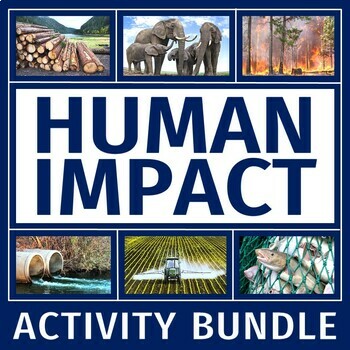Human Impact on the Environment Activity MEGA BUNDLE
Flying Colors Science
4.8k Followers
Grade Levels
7th - 10th
Subjects
Resource Type
Formats Included
- Zip
- Google Apps™
- Easel Activity
Flying Colors Science
4.8k Followers

Includes Google Apps™
This bundle contains one or more resources with Google apps (e.g. docs, slides, etc.).
Easel Activities Included
Some resources in this bundle include ready-to-use interactive activities that students can complete on any device. Easel by TPT is free to use! Learn more.
What educators are saying
My students loved this activity. They were engaged and had some great discussions within their table groups. Assignments were a little difficult for my 8th graders, but I think they learned a lot.
This bundle is a must have for any environmental science class. These high interest activities and articles fill all the minor gaps I had in the curriculum. I love the stations and the flying cats! Thank you!
Products in this Bundle (12)
showing 1-5 of 12 products
Description
SAVE 35% off list prices! Engage students with CRITICAL THINKING as you teach them about how humans have impacted ecosystems around the world. The 12 included resources provide fun, NGSS-based activities for each of the following topics:
- Habitat Destruction
- Overharvested Resources
- Invasive Species
- Water Pollution
- Air Pollution
- Land Pollution
- Biomagnification (middle school level)
- Climate Change Facts and Myths
- Carbon Dioxide and Temperature
- Carbon Dioxide Emissions
- Climate Change's Effect on Animals
- Natural Resources Around the World
Please click VIEW PREVIEW (above) to see more detail about each included resource.
Resource Descriptions:
- Habitat Destruction - Students read a background article about the Amazon rainforest and answer text-dependent questions. Then, they follow instructions that guide them through analyzing different maps of the Amazon. After the map analysis, they use what they have learned to make claims based on evidence about habitat destruction.
- Overharvested Resources - Students read real news articles about 8 overharvested species. As they read, they complete a graphic organizer and answer text-dependent questions.
- Invasive Species - Students read a background article about zebra mussels and their spread in the United States. They then graph the population changes of zebra mussels (invasive species) and swan mussels (native species). At the end, students answer analysis questions and complete a claims-evidence-reasoning question.
- Water Pollution - Eight print-and-go stations are included, each with a different focus. Station cards include text passages to read, data and graphs to analyze, or a map to interpret. As they move through the stations, students answer questions on a corresponding student worksheet.
- Air Pollution - Students practice different skills at each station while learning about different aspects of air pollution. Station cards include text to read, diagrams to analyze, data and graphs to analyze, a map to interpret, and a timeline. Students answer questions on a corresponding worksheet as they move through each station.
- Land Pollution - Students will read an introductory article about landfills, waste-to-energy facilities, composting, and recycling. Then, they graph different sets of waste-related data. Line graphs, pie charts, and bar graphs are included. Students then answer analysis questions based on the data.
- Biomagnification (middle school level) - Students read the engaging article "Flying Cats" about how cats had to be parachuted into Borneo to control rats, all because of DDT (Based on a true story!). Then, they answer text-dependent analysis questions and learn a brief lesson on bioaccumulation and biomagnification as it relates to the article.
- Climate Change Facts and Myths - Includes 15 different “2 Truths and a Lie” cards that cover many aspects of climate change. Pairs or groups of students decide which statement on each card is a lie, learning about climate change myths and truths as they go. When finished, students answer analysis questions from information in the cards.
- Carbon Dioxide and Temperature - Students read a background text about how climate data is collected. Then, they graph two sets of data on pre-labeled graphs. Finally, students answer follow-up questions, including a claims-evidence-reasoning section.
- Carbon Dioxide Emissions - Students read a background text about carbon emissions. Then, they color-code a world map based on per capita carbon emissions. Analysis questions follow.
- Climate Change's Effect on Animals - Students read interesting information about different animals and details about how climate change could affect them. Students classify the types of threats climate change poses (habitat destruction, food source disturbance, reproductive disturbance), answer text-dependent questions, and complete a claims and evidence section.
- Natural Resources Around the World - Students analyze natural resource MAPS and GRAPHS to learn more about their distribution, use, risk of depletion, and human impact on the environment. Students view the station pages and answer questions on their student sheet.
Teacher Notes:
- All answer keys provided.
- Please note that these resources are not editable.
⭐⭐⭐ Click here to get 5 FREE EARTH & SPACE SCIENCE lessons! ⭐⭐⭐
Total Pages
Answer Key
Included
Teaching Duration
N/A
Report this resource to TPT
Reported resources will be reviewed by our team. Report this resource to let us know if this resource violates TPT’s content guidelines.





